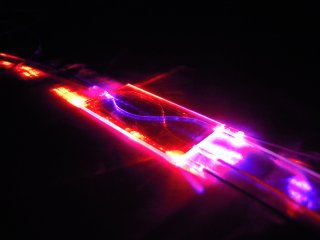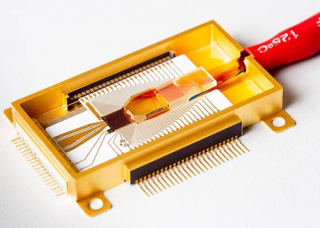If silicon is one of the main materials used by the integrated photonics industry – because it reuses the manufacturing processes in force in the microelectronic area – glass is also the subject of all attention thanks to its optical characteristics: its transparency for visible to infrared wavelengths, its low refractive index, and its linear optical properties indeed allow, in comparison with silicon, to benefit from numerous advantages at the component scale, the reduction of input/output channels footprint, better performance for passive functions, the opportunity to operate in the visible area, and greater temperature stability.
By developing a process to manufacture waveguides on glass, branded ioNext, and based on an ion-exchange reaction, Teem Photonics gives EUROPRACTICE users the opportunity to take advantage of glass assets by having a wide variety of passive components – available in a design kit that can be used through the free access design software NAZCA – to design and manufacture photonics circuits combining routing, filtering and coupling functions.
In addition, EUROPRACTICE users are also offered access to the WAFT (for Wave-guide Array to Fiber Transposers), glass interposers which are inserted between a silicon-photonics chip and an optical fiber array to ensure between these two elements a single-mode, wideband adiabatic transition, with a coupling loss of less than 0.5dB and a significant reduction in the input/output channels footprint.

Glass-photonics chip manufacturing

Light passing through a glass-photonics chip

Packaging of a silicon-photonics chip using WAFT
The ioNext platform adds two types of components which are entirely specific to it:
You can find more technical details in the ioNext PIC brochure
Glass-photonics IC ioNext-NIR | |
|---|---|
Technology Characteristics | Process: Based on a local exchange of doping ions to define gradient-index waveguides at the wafer-level Uses 60mm diameter glass wafers (will increase to 100mm soon) Requires only one photolithography step Operating range: Bandwidth from 1520 to 1570nm On-chip MFD of 4.2 x 3.2µm2 MFD converters at chip facet to match optical fibers’ MFD. Performance: Propagation loss of 0.15dB/cm at 1550nm Minimum radius of curvature of 800µm |
Building blocks | Interconnects: Straight waveguide Arc bend S-bend Optical functions: I/O port Spot size converter Surface waveguide 50/50 splitter 50/50 directional coupler Waveguide crossing Mach-Zehnder interferometer Evanescent coupling Coming soon (in the course of 2021): Polariser Multiplexer Filter |
Application area | Telecom and Datacom Optical sensing Microscopy and inspection |
Software tools | NAZCA (free and open-source framework dedicated to photonics IC design) |
Turnaround time | 1 month between the gds transmission and the chip delivery
|
Glass-photonics IC ioNext-NIR | |
|---|---|
Technology Characteristics | Process: Based on a local exchange of doping ions to define gradient-index waveguides at the wafer-level Uses 60mm diameter glass wafers (will increase to 100mm soon) Requires only one photolithography step Uses 60mm diameter glass wafers (will increase to 100mm soon) Requires only one photolithography step Operating range: Bandwidth from 650 to 800nm Mode field diameter compatible with SM630 fiber Performance: Propagation loss of 0.3dB/cm at 780nm Radius of curvature of 30mm (for the moment) |
Building blocks | Interconnects: Straight waveguide Arc bend S-bend Optical functions: I/O port 50/50 splitter Crossing |
Application area | Microscopy Spectroscopy Optical sensing and inspection |
Software tools | NAZCA (free and open-source framework dedicated to photonics IC design) |
Turnaround time | 1 month between the gds transmission and the chip delivery
|
Two types of Wave-guide Array to Fiber Transposers (corresponding to the two silicon photonics coupling configurations) are available:
Teem Photonics also makes its fiber pigtailing know-how available to EUROPRACTICE users by assembling both its WAFT and customized photonic chips with fiber arrays, thus offering lab-ready components.
Glass-photonics IC ioNext-NIR | |
|---|---|
Technology Characteristics | Process: Based on the ioNext-NIR glass-photonics platform Operating range: Operating wavelengths from 1200 to 1700nm Number of channels from 1 to 256 127µm or 250µm input pitch Output pitch down to 20µm Compatibility with both coupling modes (edge couplers and grating couplers) Various type of fiber connection: Single Mode (SM) or Polarization Maintaining (PM) fibers FC, SC, ST or MPO connectors Performance: Max insertion loss: < 1dB Max polarization-dependant loss: < 0.2dB Max adjacent crosstalk: < -25dB |
Application area | Photonic integrated circuits testing and characterization Photonic integrated circuits packaging Wafer-level testing of photonic components |
Datasheets | |